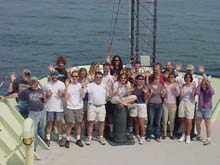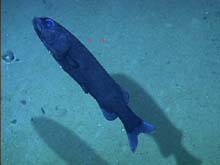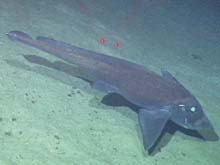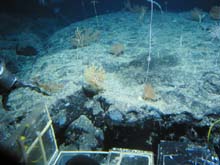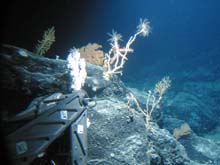Mountains in The Sea
Cruise Summary
It’s a Wrap: Another Successful Expedition to Explore Seamounts!
Catalina Martinez
OE Expedition Coordinator
The diverse group who collaborated on this exciting nine-day cruise included a multidisciplinary scientific complement of ichthyologists, geneticists, reproductive biologists, biological oceanographers, and a hydrographer, along with educators, program managers, two journalists, several graduate students, and even a scientific illustrator. All seven planned Alvin dives were successfully completed, covering about 29 hours of bottom time, and more coral samples were collected than the scientists could have imagined possible in such a short cruise. One or two new species of deep sea corals were discovered, as was at least one new species of cumacean (small shrimp-like crustacean), and the habitat range of several fish species was preliminarily extended through the findings of this expedition. Multibeam data was acquired at Kelvin Seamount, which is a region that had not been mapped at high resolution prior to this cruise. This was also the first ever visual exploration of Kelvin Seamount, the first visual examination of Bear Seamount, and only the second time that occupied submersibles have ever explored areas on Manning Seamount. Multibeam data was also acquired at Bear Seamount to complete work that was done in 2001 during the Deep East cruise, and several adjacent areas were also mapped.
Education products and outreach efforts included updates on the Ocean Explorer web site with daily logs, images, and Alvin video clips during the expedition, the development or modification of 14 lesson plans (with two more in the works) to fit with the expeditions goals and objectives, two Teacher Professional Development Institutes, and the at-sea participation of two high school teachers. During one of the dives, there was a pre-arranged satellite phone conversation between students and teachers participating in a summer program in Connecticut, and an Alvin Pilot and two scientist observers. A journalist from Science magazine covered the cruise as a participant, as did a reporter from Newsday, who submitted logs and images to the Newsday website from sea (www.linature.com). Several education/outreach products are still pending, including scientific illustrations of the seamounts and their associated biological communities, and a CD ROM/DVD for educators, that will build upon the lesson plans and incorporate cruise results.
On behalf of OE, I would like to thank the crew of the Atlantis, the Alvin crew, the scientific party, the OE team, NOAA’s Office of Coast Survey, and the education/outreach team for their dedication and hard work that resulted in another wonderfully successful cruise that far exceeded all expectations. It was an honor to participate in the exploration of yet another little-known region of our world’s oceans, and to be one of the fortunate few to witness the wonders of the deep first hand. I remain impressed by the commitment and hard work of the Atlantis and Alvin crew, as well as by the leadership of their Captain. We all recognize how fortunate we are to step into the world of occupied submersibles when we board the Atlantis and see the Alvin sub, but it is only due to this very special cohesive crew that an expedition such as this actually comes together. Many of the scientists and crew on board also participated in Deep East 2001, which was another good example of a cruise in which a great deal was accomplished in a very short amount of time. Congratulations to you all for your successes and accomplishments in exploring the New England Seamount chain!
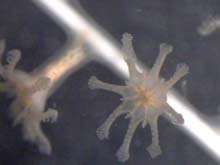
This image of individual polyps of a chrysogorgiid coral was taken through a dissecting microscope. Photo courtesy of Skip Forest. Click image for larger view.
Reproductive Morphology of Deep-Water Octocorals
Anne Simpson
Graduate Student
University of Maine
As a graduate student, my main objective on the Mountains in the Sea 2003 cruise was to collect polyps containing reproductive cells from a variety of alcyonaceans (animals from the order of octocorals that I’m studying). Back in the lab where I work, I will examine cellular and sub-cellular structures in these cells using both light and electron microscopes. The aims of my research are to: (1) gain a broader understanding of the reproductive biology and ecology of deep-water octocorals; (2) use reproductive characters to determine phylogenetic relationships among certain species and higher groups of deep and shallow-water octocorals.
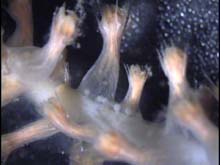
This image of individual polyps of a isidid coral was taken through a dissecting microscope. We are excited about the possibility that the small round structures you see beneath the polyps are eggs. Photo courtesy of Skip Forest. Click image for larger view.
While on the R/V Atlantis, I worked in one of the science laboratories where two other graduate students and I dissected out individuals polyps from many different species of octocorals that had been collected by the Alvin submersible. I used a microscope to locate the reproductive cells within octocorals polyps. Polyps removed from the colony were placed in sequential preservative solutions and soaked for specific amounts of time. In addition to collecting material for later observation, video of live octocorals with open polyps was taken using an on-board videomicroscope. A few colonies were recorded in the process of extruding reproductive cells.
Highlights of Fish Research
Peter Auster
University of Connecticut
Jon Moore
Florida Atlantic University
One of the major goals of the expedition was to investigate the relationship of fishes and associated species (like squids) with features of seamount landscapes. We saw approximately 18 species of deep sea fishes, which is not many when one considers shallow water fish communities but is substantial when working in the deep sea. The six dives showed us that fish are distributed very unevenly around seamounts and there are apparent differences between seamounts. For example, very few species were seen at Kelvin Seamount but many more were observed at Manning and Bear Seamounts.
From our limited observations, there are associations of some species with particular features of the seafloor landscape. Shelter from currents is important when trying to conserve energy while searching for prey. Hakes and cusk-eels were observed in the shelter of basalt crevices searching for prey while halosaurs found shelter over sediment ripple features. Further, the behavior of fishes revealed interesting strategies of foraging for prey. Grenadiers and halosaurs were observed in “head-up” and “head-down” postures drifting with the current over the seafloor. These behaviors may allow fishes to be more efficient at ambushing prey such as small shrimp and fishes. Halosaurs were also observed using their tails as “sails”, allowing the current to push them over the seafloor in a relatively effortless search for prey.
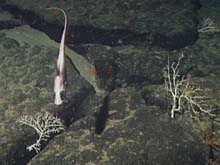
A grenadier (rattail) swimming amongst the crevices of basalt outcrops and corals. Click image for larger view.
Fish census data will also provide new information on the geographic distribution of some species. Traditional sampling with nets can miss species that occur in rocky habitats or along the steep sides of seamounts. Further, such observations allow us to better interpret patterns found with more traditional sampling such as trawls. Trawl catches of slickheads, Alepocephalus sp., from previous sampling on Bear Seamount had always resulted in animals occurring in groups rather than singly, suggesting they were schooling fishes. However, observations of three fishes from Alvin showed us they occur singly while foraging on the seafloor. With the aid of research submersibles, a more complete picture of the animals that live on and over seamounts can be obtained.
This work has led to many new questions, including how the local oceanographic regime and seafloor features interact to produce landscape features that are relevant to the distribution and abundance of fishes. Much work needs to be completed video images and verifying species identifications. However, we have made a significant leap in our understanding the lives of fishes on the New England Seamounts.
Biodiversity on the New England Seamounts
Dr. Jon A. Moore
Florida Atlantic University
Photographic surveying and selective sampling during this expedition has impressively expanded our knowledge of the animals living on these seamounts. Hard substrates foster a diverse assemblage of attached organisms, with sponges and octocorals visually dominating these areas, whereas crinoids and brittle stars often numerically dominate. Areas of sand and finer sediments harbor a wide array of more mobile animals, especially echinoderms and fishes, plus a diverse fauna of burrowing animals under the sediment surface. Bottom types ranged from solid basalt to manganese crusts to rock and coral rubble to mixtures of pebbles and sand to fine oozes. Because of the variety of bottom types found on these seamounts, many different animals can occur over a short distance. These seamounts truly are islands of high diversity in the deep sea.
It will take several years for all the experts to identify the animals collected and describe any potentially new species collected. Most of the over 440 specimens collected from the seamounts will be deposited in the Smithsonian’s National Museum of Natural History and the Peabody Museum of Natural History at Yale University. Our preliminary collections indicate at least 20 octocoral species, 3 stony coral species, 7 species of sponges, 20 species of polychaete worms, 18 crustaceans, 11 molluscs, 8 species of brittle stars, 5 sea stars, 5 anemones and several other invertebrates live on these seamounts. Analysis of the photographic evidence will also take some time, but will considerably expand the list of species even further.
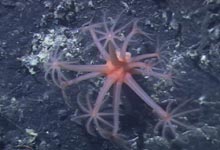
This Anthomastus is viewed through the external cameras on Alvin. The polyps are extended now but will retract when Alvin comes a little closer. Click image for larger view.
Deep Sea Coral Distributions
Les Watling
One of the objectives for this cruise was to obtain information about the distribution and ecology of deep water corals, specifically in the group usually referred to as gorgonians. The cruise was a spectacular success with regard to this objective. Very large numbers of corals were observed and recorded on video at both manning and Kelvin seamounts. At least 16 species of octocorals, 7 species of antipatharians (the black corals), and 3 species of hard corals were collected. The octocorals were used for genetic and reproductive biology analysis.
While on the bottom, we took advantage of the fantastic camera capabilities of Alvin and recorded the octocorals with their polyps extended. Since they live at such great depths the opportunity to observe them alive is severely limited. We are interested in understanding how these animals feed and what they feed on and used these observations to determine whether the tentacles of the polyp were used to “flick” food particles toward the mouth.
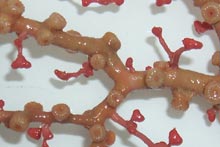
A close-up of the polyps on a sample of Paragorgia collected at Kelvin Seamount. The polyps are in a closed position. Click image for larger view.
We were also interested in the biogeography of the corals found on the seamounts with respect to what we know about coral distributions on the continental slope of the eastern United States. Most of the corals seen on the seamounts are not common, if present at all, on the continental slope. There also appeared to be some zonation with depth on the seamount with some coral species being very common on the side and others becoming more dominant near the rim and on the summit. All seamounts were sediment covered at the summit with some exposed rock, so corals were not as common on the summits as on the sides.

Overview of Bear, Kelvin, and Manning Seamounts. The rainbow-colored strips are areas mapped with the Atlantis’s Seabeam 2112 multibeam sonar during both the current cruise and a previous cruise in 2000. The background digital terrain model (DTM) and contours are derived from data obtained from the National Geophysical Data Center. Click image for larger view.
Mapping the Mountains of the Sea
Ivar G. Babb, NURC –
University of Connecticut
Nick Forfinski
NOAA
NOAA Ship Thomas Jefferson
Making maps is the first product of an explorer. As such, mapping the Mountains of the Sea – the New England Seamounts was the first objective of this research cruise. The New England seamounts form a southeast trending chain of underwater peaks, running from Bear seamount (200 miles from Woods Hole, MA) for another 700 miles to Nashville seamount. Our mission focused upon three seamounts: Manning, Kelvin and Bear. To map the seamounts we used the R/V Atlantis’ Seabeam 2112 12KHz swath bathymetric sonar system. Since the R/V Atlantis sails to all of the earth’s oceans, this system is able to provide bathymetric charting and seafloor acoustic backscatter imaging in water depths ranging from 10 to 11,000 meters. This translates into a map swath under the ship that varies as a function of depth getting narrower as the ship gets into deeper water (e.g. the mapping sonar beam is 150 degrees at 1,000 meters, 120 degrees at 5,000 meters and 90 degrees at 11,000 meters). As its name implies, a multibeam sonar sends multiple sonar pulses out from the hull mounted transducers and records the time it takes for the signal to return from the seafloor to calculate depth. This requires impressive data storage and number crunching capability.
The cruise track for our short mission (9 days) took us from Woods Hole, MA to the southernmost seamount Manning, where two dives were planned. From there we would transit overnight north to Kelvin, dive for two more days, then steam overnight, dive two days on Bear seamount, then return to Woods Hole. Our mapping plan, therefore, was to conduct one swath over the peak of the sausage-shaped Kelvin seamount on our way to Manning. We were fortunate to have the assistance of our collaborator, Dr. Jess Adkins from California Polytechnic Institute, who provided us with multibeam maps of Manning seamount that were invaluable for planning our first two Alvin dives. Finally, we had a multibeam map of Bear seamount from the 2001 Deep East cruise.

Looking northeast towards Bear Seamount with Physalia Seamount in the background. About 200 miles from Woods Hole, MA, flat-topped Bear Seamount rises approximately 2000 meters from the surrounding ocean floor to a depth of 1100 meters. Click image for larger view.
We were able to complete the mapping of the series of peaks that comprise Manning during our one evening on site. Manning is a complex, large series of peaks or edifices. Existing bathymetric charts indicated the gross morphology of this mountain complex, with the multibeam filling in the finer scale topography that was critical for our dive planning to locate deepwater corals.
We used the one swath over Kelvin seamount to plan the first dive on the incredibly steep west slope of the large east-west trending feature. During the evening we were able to conduct two more swaths over the mountain to produce a complete map of the mountain. Similarly, we were able to “mow the lawn” – conduct four parallel cruise tracks over the seamount to provide complete mapping coverage to add to our existing data from Bear. Seamount. The data will be used by NOAA to augment existing charts of these significant offshore features.
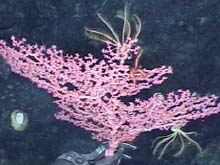
Collecting a colony of Paragorgia using Alvin’s manipulator arm on Manning Seamount at 1483 meters depth. Two yellow crinoids and an orange brittle star can be seen clinging to the coral’s branches. Click image for larger view.
Coral Genetics
Scott C. France
College of Charleston
One of the objectives of the mission was to characterize the genetic diversity of deep-water corals observed on the New England Seamounts. We had two strategies in collecting, each of which provide samples to address different issues in the evolution of these corals. On the one hand, we wanted to maximize the number of different corals sampled so that species diversity can be accurately assessed. We sampled 20 different coral species for genetics on the three seamounts we visited, including six black corals and one stony coral. These samples will be DNA sequenced and compared to a DNA database being developed by Dr. France for use in coral species identification. Our second collection strategy was to sample multiple individuals of several coral species to assess genetic diversity within a species between seamounts.
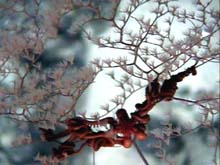
Close-up of polyps of the octocoral Metallogorgia with a single red brittle star, Asteronyx. Click image for larger view.
These genetic diversity data can ultimately be used to estimate the amount of larval dispersal between the seamounts. For this objective, we sampled tissue from seven species found on more than one seamount. Genetic analyses will be conducted in Dr. Scott France’s lab at the College of Charleston. When analyses are complete, the DNA sequences will be available to the public through online access at GenBank.




















